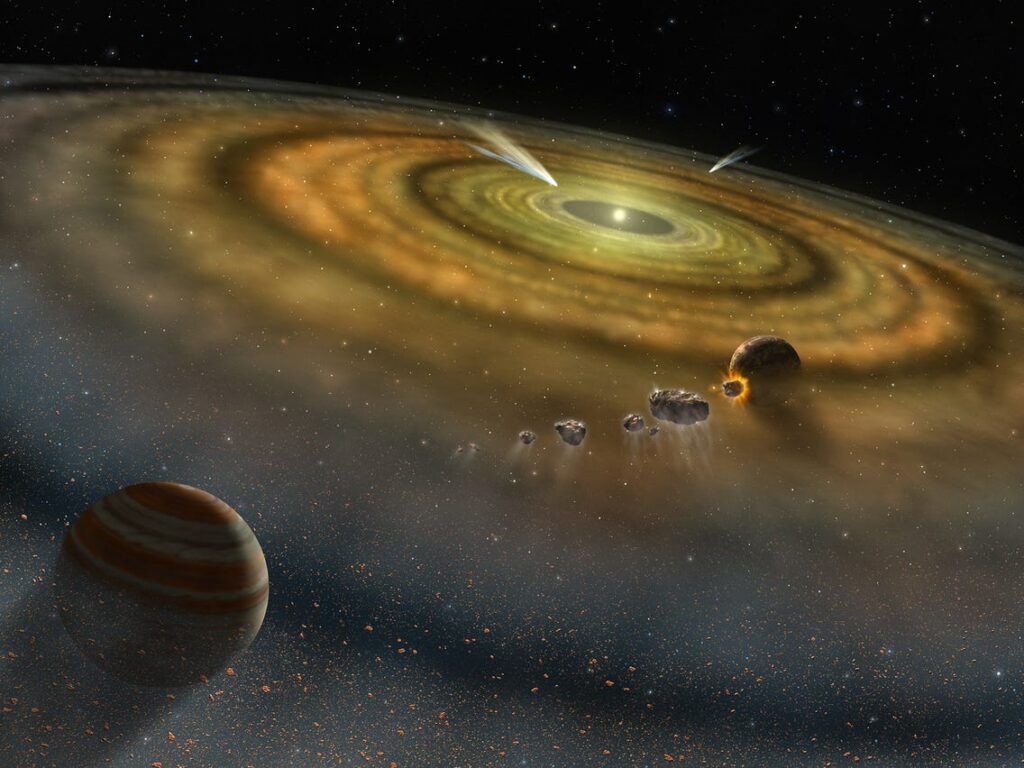When we think about matter we think about atoms, but Srimad Bhagavatam explains it in a different way, focusing on the practical aspects of material experience. It explains how the material experience, as well as the tools we use to experience it, are created.
According to the Vedas, all material objects are a combination of the five material elements:
1- nabha or ākāśa (space, or ether)
2- anila or marut (air)
3- tejas or agni (fire, light and electricity)
4- ambha or āpas (water and liquids)
5- pṛthvī or bhūḥ (earth, including all the other gross elements)
These elements are created together with the senses that can experience them. There is no point in having eyes if there are no forms to be seen, there is no point in having ears if there are no sounds to be heard, etc. Similarly, there would be no point in form, sound, and taste existing if there were no one to experience them, therefore, they come together. From the moment sound is created, the possibility of hearing such sounds (the sense of hearing) is created, when forms are created, the possibility of seeing such forms (vision) is created, and so on.

Nabha, the element ether mentioned here is not connected with the disproven theory of the luminiferous ether from past centuries, nor is it just a vacuum, like in space. The Vedic conception of ether is a subtle element that serves as a fabric or support for all the other material manifestations. Ether is everywhere and pervades everything. It sustains all forms of matter and energy, just like the canvas used to make a painting. Everything starts with this fabric of ether, and everything else exists on top of it.
The Vedas explain that ether can conduct sound. Of course, the gross sounds we can hear depend on the presence of atoms that can conduct the vibration, but there are subtle forms of sound that can travel on ether. Even in our gross reality, radio signals can travel through the vacuum of space. In other words, even in the absence of gross matter, ether is present and it transports the radio signals, as well as other types of subtle sound we are not capable of using. The creation of the element ether thus comes together with the creation of sound and the sense of hearing.
Next, anila, or air is created, together with the sense of touch. We can’t see air (when it’s pure), we can’t taste or smell it, but we can easily feel it when we move our arms. Thus, the creation of air comes together with the sense of touch. If we trace a parallel with modern theories, ether is equivalent to the very fabric of space and time, while air corresponds to hydrogen and other gases, which in turn give birth to the stars.
The next element is tejas, light or fire, which also includes form. Sound can pass through fire and we can surely feel its warmth, but fire adds a third quality which is form. Different from pure air or ether, fire can be seen, and thus it comes together with the sense of vision. “Fire” in this case doesn’t mean just a flame burning, it is a generic term for all manifestations of light, electricity, heat, and combustion, including the light of the sun and stars.
The fourth element is ambha, or water. Pure water doesn’t have smell, but it has taste. It also has form and can transmit sound. We can surely also feel it with our hands. Thus, water has all the three previous properties, and add one more, which is taste. Together with the creation of water, comes the sense of taste, that allows us to experience it.
The final element is pṛthvī or earth, the grossest, which includes all the four previous qualities, and adds smell, which leads to the creation of the last of the five senses.
The creation of the last three elements also follows a logic similar to what is believed in modern theories. According to them, after the creation of the fabric of space and time, matter cools down, forming the first atoms, mainly hydrogen, which in turn, due to the action of gravity, form the first stars. The process of nuclear fusion inside the stars produces not only light and heat (fire) but also all the heavier elements, including oxygen (which in turn combines with hydrogen, creating water), as well as carbon, silicon, iron, and so on, which the Vedas collectively describe as the element earth. We can see that the two explanations are quite similar, but they follow different logic. Modern theory tries to explain the creation of the universe in terms of the creation of atoms and physical laws, while the Vedas give a broader perspective, focusing on the metaphysical aspects.
According to the Vedas, reality exists on several different levels. There are levels of existence much more refined than the reality we currently experience. In our current level, matter is composed of atoms, but in subtler levels matter has a different nature, not being based on physical particles. Matter there is still composed of the five elements (earth, water, fire, air, and ether), but is not based on gross atoms like here. Thus, the Vedas explain the five original elements that are used to constitute all types of matter in all different planes, and not just on gross atoms, which are relevant only to our particular plane.
